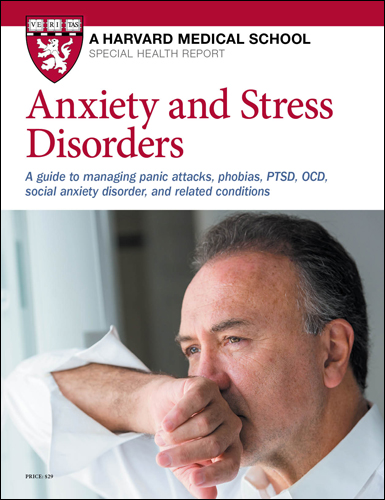Harvard Health Blog
Do I have anxiety or worry: What's the difference?

Have you ever thought about starting a new job or school, and found your heart pounding and your mind racing with a series of "what ifs"? If so, you may wonder "do I have anxiety?"
Anxiety is your body's natural threat response system. When your brain believes you are in danger, it sends out a series of signals to your body, resulting in the fight-or-flight response.
Worry is a component of anxiety symptoms
Anxiety has three main components: emotional, physiological, and cognitive.
Imagine you have a presentation coming up at work. You might notice feelings of fear and dread, two examples of the emotional component. You may also notice bodily sensations, such as heart palpitations, sweating, or a tightness in your stomach, which represent the physiological component. Finally, you might be thinking, "I can't do it," or "I'm going to embarrass myself." Worries and negative thoughts like these about what might happen in the future are the cognitive component. So, while worry is an important part of anxiety, it is only one of the three main building blocks.
The anxiety disorder spectrum
Anxiety in itself is not bad. Normal levels of anxiety lie on one end of a spectrum and may present as low levels of fear or apprehension, mild sensations of muscle tightness and sweating, or doubts about your ability to complete a task. Importantly, symptoms of normal anxiety do not negatively interfere with daily functioning. They may actually improve your attention and problem-solving, motivate you to work harder toward a goal, or warn you about a potential threat. For example, anxiety about an upcoming exam will likely drive you to prepare fully, and the anxiety a hiker might experience when encountering a bear allows the hiker to run away to safety. These examples demonstrate how normal levels of anxiety can be adaptive and helpful to your everyday life.
Clinical levels of anxiety fall toward the other end of the spectrum. Diagnosable anxiety disorders occur when anxiety levels rise enough to rapidly decrease performance and cause impairment.
How would you know if you have crossed over into the zone of a full-blown anxiety disorder? Anxiety disorders are characterized by severe, persistent worry that is excessive for the situation, and extreme avoidance of anxiety-provoking situations. These symptoms cause distress, impair daily functioning, and occur for a significant period. For instance, a person who needs to stay home from work several days in a row due to panic attacks is likely suffering from an anxiety disorder.
Different evidence-based treatments are most effective for different anxiety disorders. For example, a man suffering from panic disorder would likely benefit from exposure therapy, while a woman suffering from social phobia might be best treated with cognitive behavioral therapy (CBT). If you believe you may have an anxiety disorder, seek help as soon as possible.
What Is "almost anxious" and how can you handle it?
As anxiety moves along the spectrum from normal to clinical, a gray area in the middle may still have a negative impact on your life: the "almost anxious" region. When the level of anxiety you experience is no longer adaptive or helpful to your performance and becomes a barrier to your enjoyment of life, but does not yet meet the diagnostic threshold for an anxiety disorder, you are "almost anxious." You might find yourself struggling to focus your attention on tasks, distracted by negative thoughts, fear, or unpleasant body sensations. For example, someone who is "almost anxious" may sit at their desk all day, making minimal progress on an assignment due to constant worries and tightness in the stomach. While anxiety did not make it impossible to come to work, the level of anxiety experienced is making it hard to function. Using this concept of "almost anxious" can help you catch anxiety before it becomes too extreme, and target it using evidence-based strategies that help move anxiety back along the spectrum to an adaptive level.
When you find yourself feeling too anxious, try evidence-based techniques highlighted in the book Almost Anxious to bring your anxiety levels back to normal. Here are a few tools to try:
- If you find yourself thinking, "I can't do this," "I'll never get this assignment done," or a similar negative thought, challenge this by asking if it is valid or helpful. You will likely find that these thoughts are merely fueled by your anxious brain, so stopping them in their tracks is important.
- If your thoughts seem to be spiraling out of control, take a few minutes to practice mindfulness. Focusing on the present moment takes your thoughts away from the past and future, helping you re-center yourself.
- Identify situations that make you anxious, and approach them instead of avoiding them. For example, if you are afraid of public speaking, talk in front of others as often as possible. Over time, you will find the discomfort fades away as you face the very things that used to cause you anxiety!
About the Author

Luana Marques, PhD, Contributor
Disclaimer:
As a service to our readers, Harvard Health Publishing provides access to our library of archived content. Please note the date of last review or update on all articles.
No content on this site, regardless of date, should ever be used as a substitute for direct medical advice from your doctor or other qualified clinician.
















